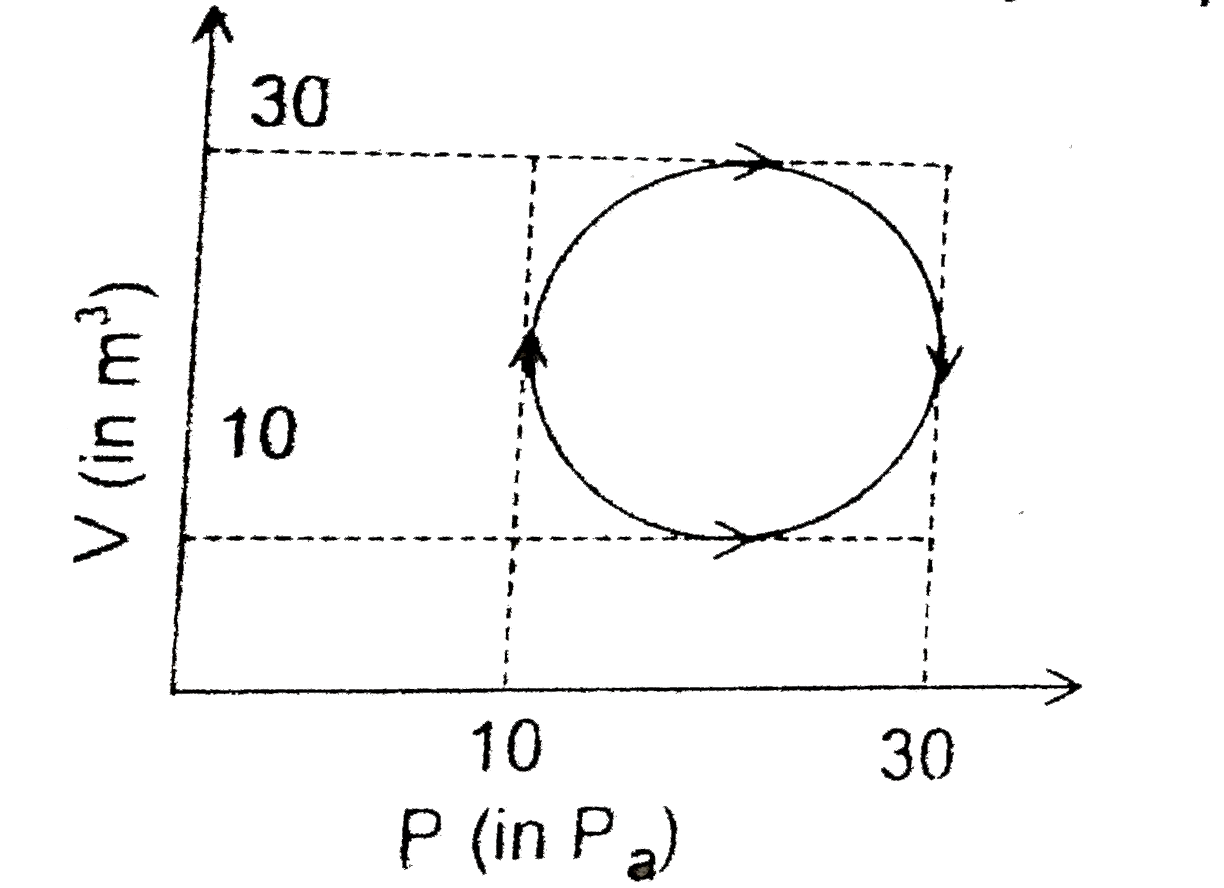A closed system receives 200kJ of heat at constant volume. It then rejects 100kJ of heat while it has 50kJ of work done on it at constant pressure. If an adiabatic process can be found which will restore the system to its initial state, the work done by the system during this process is
(a) 100kJ
(b) 50kJ
(c) 150kJ
(d) 200kJ
The correct Answer is:C
To solve the problem step by step, we will analyze the processes involved and apply the first law of thermodynamics.
Step 1: Identify the Processes
The system undergoes three processes:
1. Process A to B (Isochoric): The system receives 200 kJ of heat.
2. Process B to C (Isobaric): The system rejects 100 kJ of heat and has 50 kJ of work done on it.
3. Process C to A (Adiabatic): We need to find the work done by the system during this process.
Step 2: Apply the First Law of Thermodynamics
The first law of thermodynamics states:
ΔU=Q−W
Where:
- ΔU is the change in internal energy,
- Q is the heat added to the system,
- W is the work done by the system.
Since the system returns to its initial state (cyclic process), the change in internal energy over the entire cycle is zero:
ΔU=0
Step 3: Calculate Net Heat and Work
For the entire cycle, we can express the net heat and work:
Qnet=QAB+QBC+QCA
Wnet=WAB+WBC+WCA
From the problem:
- QAB=200 kJ (heat added)
- QBC=−100 kJ (heat rejected)
- QCA=0 kJ (adiabatic process)
So,
Qnet=200−100+0=100 kJ
For work:
- WAB=0 kJ (no work done in isochoric process)
- WBC=−50 kJ (work done on the system)
- WCA=WC→A (work done by the system, which we need to find)
Thus,
Wnet=0−50+WCA
Step 4: Set Up the Equation
Since ΔU=0, we have:
Qnet=Wnet
Substituting the values:
100=−50+WCA
Step 5: Solve for Work Done in the Adiabatic Process
Rearranging the equation gives:
WCA=100+50=150 kJ
Final Answer
The work done by the system during the adiabatic process (C to A) is 150 kJ.
---
The system undergoes three processes:
1. Process A to B (Isochoric): The system receives 200 kJ of heat.
2. Process B to C (Isobaric): The system rejects 100 kJ of heat and has 50 kJ of work done on it.
3. Process C to A (Adiabatic): We need to find the work done by the system during this process.
The first law of thermodynamics states:
ΔU=Q−W
Where:
- ΔU is the change in internal energy,
- Q is the heat added to the system,
- W is the work done by the system.
ΔU=0
For the entire cycle, we can express the net heat and work:
Qnet=QAB+QBC+QCA
Wnet=WAB+WBC+WCA
- QAB=200 kJ (heat added)
- QBC=−100 kJ (heat rejected)
- QCA=0 kJ (adiabatic process)
Qnet=200−100+0=100 kJ
- WAB=0 kJ (no work done in isochoric process)
- WBC=−50 kJ (work done on the system)
- WCA=WC→A (work done by the system, which we need to find)
Wnet=0−50+WCA
Since ΔU=0, we have:
Qnet=Wnet
Substituting the values:
100=−50+WCA
Rearranging the equation gives:
WCA=100+50=150 kJ
The work done by the system during the adiabatic process (C to A) is 150 kJ.
Topper's Solved these Questions
- BOOK - DC PANDEY ENGLISHCHAPTER - LAWS OF THERMODYNAMICSEXERCISE - Level 2 More Than One Correct6videos
LAWS OF THERMODYNAMICS
- BOOK - DC PANDEY ENGLISHCHAPTER - LAWS OF THERMODYNAMICSEXERCISE - Level 2 Passage I2videos
LAWS OF THERMODYNAMICS
- BOOK - DC PANDEY ENGLISHCHAPTER - LAWS OF THERMODYNAMICSEXERCISE - Level 1 Subjective24videos
LAWS OF THERMODYNAMICS
- BOOK - DC PANDEY ENGLISHCHAPTER - LAWS OF MOTIONEXERCISE - Medical entrances gallery39videos
LAWS OF MOTION
- BOOK - DC PANDEY ENGLISHCHAPTER - MAGNETIC EFFECT OF CURRENT AND MAGNETISMEXERCISE - Integer type Questions10videos
MAGNETIC EFFECT OF CURRENT AND MAGNETISM
Similar Questions
Knowledge Check
- Question 1 - Select One
An ideal gas system undergoes an isothermal process, then the work done during the process is
AnRTln(V2V1)BnRTln(V1V2)C2nRTln(V2V1)D2nRTln(V1V2)
Can work be done by a system without changing its volume?
View SolutionIn which of the following changes at constant pressure, is work done by system on surrounding ?
View SolutionThe internal energy of a system remains constant when it undergoes
(i) a cyclic process
(ii) an isothermal process
(iii) an adiabatic process
(iv) any process in which the heat given out by the system equal to the work done on the systemView Solution
A system works under cyclic process as follow
Heat absorbed during the process isView SolutionA system absorbs 10kJ of heat at constant volume and its temperature rises from 270C to 370C. The ΔE of reaction is
View SolutionIn an isobaric process of an ideal gas. The ratio of heat supplied annd work done by the system [i.e.,(QW)] is
View SolutionFor a gaseous state if heat supplied to the system is 100 J and work done by the system is 25 J. then internal energy of the system is
View Solution


